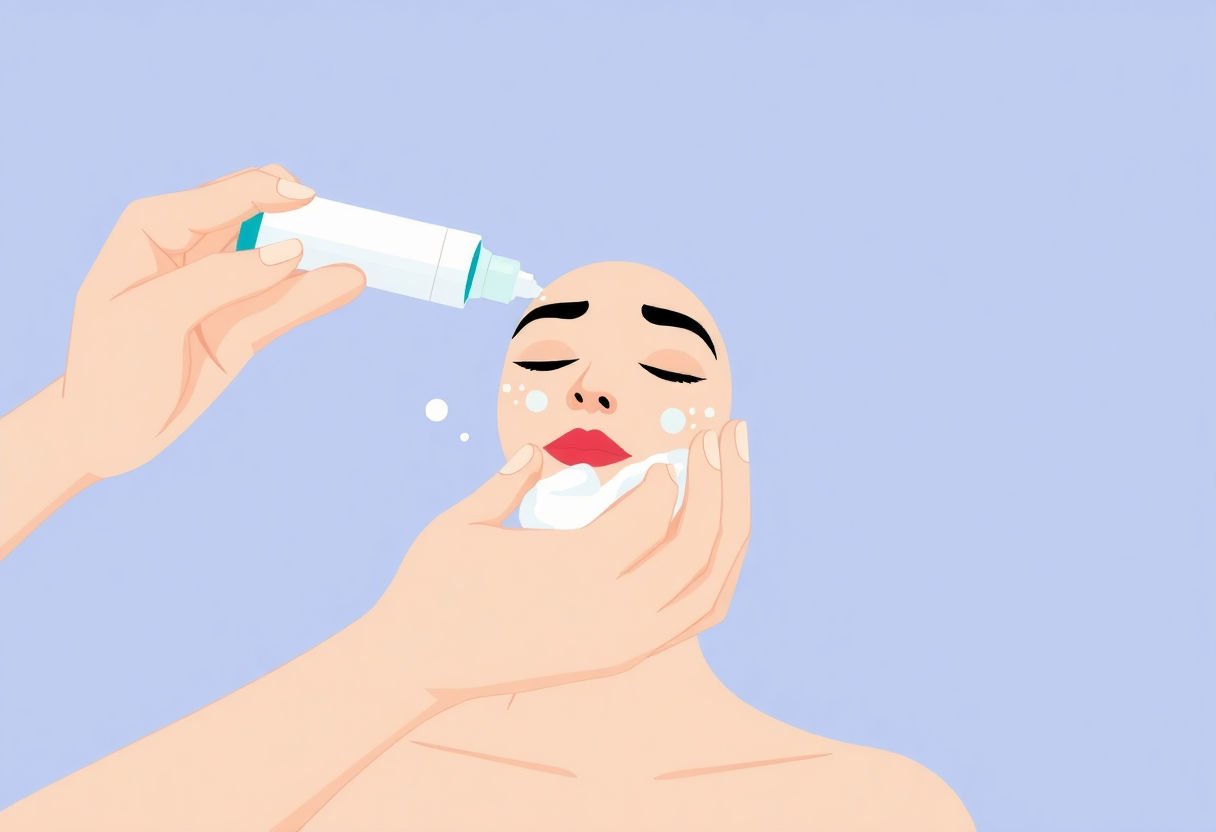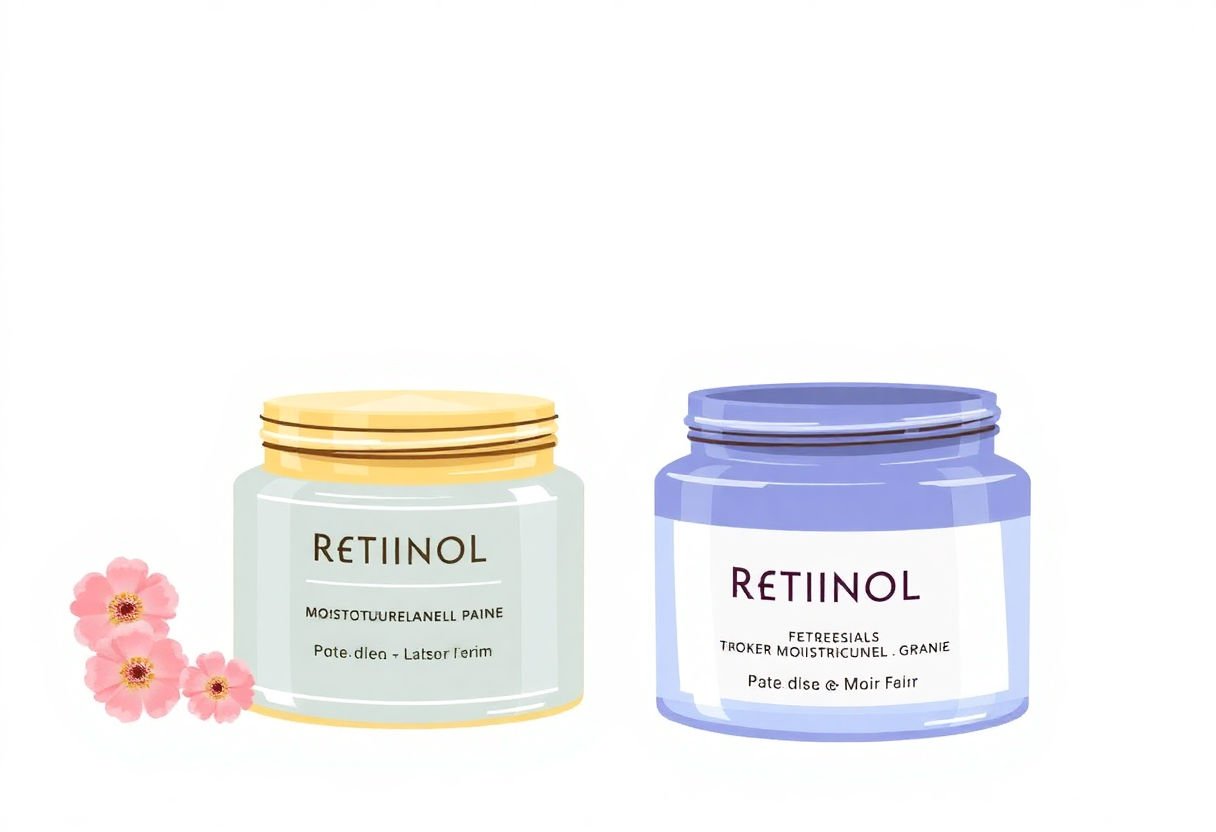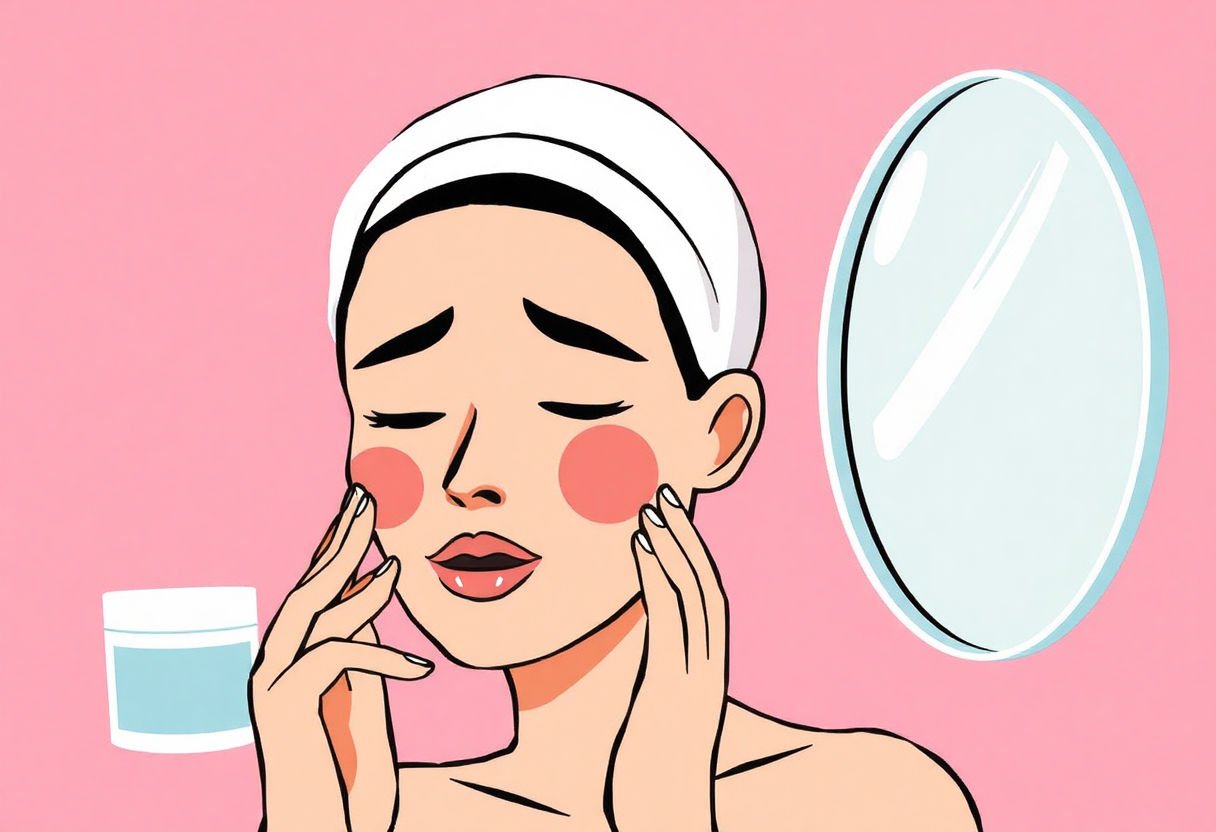In crafting an effective skincare routine, understanding the sequence of application is crucial, particularly when it involves potent ingredients like retinol and fundamental products such as moisturizers. Whether you aim to combat signs of aging, address acne, or maintain radiant skin, the order in which these products are applied can significantly influence their effectiveness. This article delves into the roles and benefits of retinol and moisturizers, providing insights on their application and integration into your daily regimen. By exploring optimal practices and common mistakes, you’ll gain valuable knowledge for customizing a skincare routine that caters to your specific skin needs.
Key Takeaways
- Retinol, a form of Vitamin A, is essential for promoting skin cell turnover and reducing signs of aging.
- To maximize retinol’s effectiveness, apply it before moisturizer to ensure adequate skin penetration.
- Moisturizers play a critical role in locking in hydration and soothing the skin, particularly after retinol application.
- Combining retinol and moisturizer can enhance skin benefits while minimizing potential irritation from retinol.
- Tailoring the skincare routine based on your skin type can help avoid common application mistakes and adverse effects.
The Role of Retinol in Skincare
Retinol, a derivative of vitamin A, plays a pivotal role in modern skincare routines due to its potent ability to enhance skin texture and appearance. Retinol works by accelerating cell turnover, encouraging new cell growth, and shedding dead skin cells, which can help reduce the appearance of fine lines and wrinkles. Its exfoliating properties also assist in unclogging pores, making it an effective treatment for acne.
Benefits of incorporating retinol into your skincare regimen are numerous. In addition to promoting smoother skin, retinol helps to even out skin tone and diminishes hyperpigmentation. With consistent use, it can significantly lighten age spots and reduce sun damage, unveiling a more radiant complexion.
A compelling quote from a renowned dermatologist encapsulates its significance: “Retinol is one of the few ingredients with well-studied, scientifically-backed evidence showing its potential to reverse the signs of aging.”
However, integrating retinol must be approached with care. Start by applying it sparingly, preferably in the evening, and give your skin time to adjust. Overuse or improper application can lead to irritation, redness, or peeling, particularly for individuals with sensitive skin.
In summary, retinol can be a transformative addition to any skincare routine, but it is crucial to introduce it gradually and monitor your skin’s response. By understanding its role and functionality, you can harness its ability to rejuvenate the skin effectively.
How Moisturizer Benefits Your Skin
Moisturizers play a crucial role in maintaining skin hydration, serving as a protective barrier and preventing water loss. They are designed to keep the skin supple and soft, which is essential when using active ingredients like retinol that can cause dryness and irritation.
Key Benefits of Moisturizers:
-
Hydration: Moisturizers help retain water in the outermost layer of the skin. This is vital for maintaining a healthy glow and preventing flakiness.
-
Barrier Function: By forming a protective layer on the skin’s surface, moisturizers prevent the loss of essential moisture and shield against environmental aggressors like pollution and harsh weather conditions.
-
Soothing Properties: Many moisturizers contain ingredients like aloe vera and chamomile that calm and reduce inflammation, making them particularly useful for sensitive skin types.
-
Enhanced Skin Texture: Regular use of moisturizers can result in smoother, more elastic skin, which contributes to a youthful appearance.
-
Complementing Other Treatments: Using a moisturizer after applying retinol can mitigate potential dryness and enhance the efficacy of your skincare routine by allowing other ingredients to penetrate better.
Dermatologists often emphasize the necessity of selecting a non-comedogenic formula to avoid clogging pores, particularly for individuals with acne-prone skin. Additionally, moisturizers with SPF can provide dual benefits by also offering protection from ultraviolet rays.
Incorporating a suitable moisturizer into your regimen doesn’t just enhance comfort; it is an essential step toward achieving balanced, healthy skin.
Best Practices for Applying Retinol
Before incorporating retinol into your skincare routine, it is essential to understand the proper techniques and timing for its application to harness its full potential. Retinol, a powerful derivative of vitamin A, demands careful handling due to its potency and potential for causing skin irritation. Here are some best practices for applying retinol:
-
Introduce Retinol Gradually: For those new to retinol, it is advisable to start by applying it two to three times per week. Gradually increase the frequency as your skin builds tolerance, aiming for nightly use if your skin can handle it.
-
Apply Retinol at Night: Retinol is highly sensitive to sunlight, which can degrade its effectiveness and increase skin sensitivity. Therefore, apply retinol as part of your nighttime skincare routine.
-
Use a Pea-Sized Amount: A small amount goes a long way. Dispense only a pea-sized amount of retinol, evenly smoothing it over your entire face. Applying more can lead to irritation without enhancing results.
-
Avoid Sensitive Areas: Retinol can irritate delicate skin around the eyes and lips. Exercise caution and avoid these areas unless using a retinol product specifically designed for such regions.
-
Layering with Moisturizer: To minimize potential dryness or irritation, consider applying a moisturizer after retinol. Alternatively, apply a light layer of moisturizer beforehand if your skin is particularly sensitive. This method, known as buffering, can help in cushioning the effects of retinol.
These guidelines ensure not only the maximum efficacy of retinol but also prioritize the health and comfort of your skin.
When to Apply Moisturizer in Your Routine

Applying moisturizer at the right time in your skincare routine is crucial for maintaining optimal skin health and enhancing the effectiveness of other products, such as retinol. Moisturizers should ideally be applied after cleansing and applying any treatment products, such as serums or retinol.
The primary function of a moisturizer is to lock in hydration and create a protective barrier on the skin’s surface, minimizing water loss. This step should follow the application of retinol, as it helps to soothe the skin and mitigate any irritation that retinol might cause.
Applying moisturizer post-retinol creates a balanced environment on your skin, allowing the retinol to work without causing over-dryness. According to dermatology guidelines, it is often recommended to wait a few minutes after applying retinol before smoothing on your moisturizer to ensure the retinol has adequately absorbed into the skin.
Additionally, choosing the right type of moisturizer for your skin type and the specific ingredients it contains can play a significant role. For instance, look for moisturizers with hyaluronic acid if you require extra hydration, or those with ceramides to strengthen the skin barrier.
Ultimately, by incorporating a moisturizer at the right phase of your skincare routine, you not only reinforce the effectiveness of retinol but also ensure a comfortable, hydrated, and healthier complexion. This strategic order and timing maximize the benefits garnered from both potent skincare elements, thereby contributing to overall dermatological health.
Combining Retinol and Moisturizer

To unlock the full potential of both retinol and moisturizer in your skincare routine, it’s crucial to understand how to effectively combine these products. These potent allies, when used correctly, can complement each other to support skin health without compromising their unique benefits.
Layering for Optimal Absorption
When incorporating retinol and moisturizer into your routine, consider applying retinol first. This allows your skin to absorb the active ingredient efficiently. Retinol works by promoting cell turnover, thereby enhancing the skin’s texture and tone. For optimal results, ensure your skin is dry before application, as moisture can enhance penetration, which might lead to irritation.
After giving the retinol a couple of minutes to absorb, follow up with a moisturizer. Applying a moisturizer can help to seal in moisture, providing a protective barrier that aids in reducing potential dryness and irritation often associated with retinol usage. This sequential application ensures that the retinol can work effectively while the moisturizer minimizes any adverse effects.
Buffering to Reduce Sensitivity
For those with sensitive skin, a technique called buffering might be beneficial. Buffering involves applying a layer of moisturizer before the retinol. This acts as a buffer, reducing the strength of retinol’s effects and minimizing irritation. Follow with another layer of moisturizer post-retinol to lock in hydration.
Considerations for Successful Integration
- Start Slow: Introduce retinol slowly to your regimen, starting with applications twice a week and gradually increasing frequency as your skin builds tolerance.
- Hydration is Key: Choose a moisturizer enriched with hydrating ingredients such as hyaluronic acid or ceramides to support skin barrier function.
- Personalize Your Routine: Adjust the products you choose based on your specific skin needs and concerns, ensuring they complement each other without overwhelming your skin.
By understanding how to strategically combine retinol and moisturizer, you can maximize their benefits while maintaining healthy, radiant skin.
Potential Side Effects of Retinol

Retinol is widely celebrated for its remarkable ability to improve skin texture and reduce signs of aging; however, its usage can sometimes lead to undesirable side effects, especially for those new to the product or with sensitive skin. Understanding these potential side effects is crucial for anyone looking to incorporate retinol into their skincare routine effectively.
Common Side Effects and Their Mitigation
-
Dryness and Peeling: Retinol accelerates cell turnover, which can lead to dryness and flaking. To mitigate these effects, it’s advisable to start with a low concentration of retinol and apply it only a few times a week. Integrating a robust moisturizer in your routine can help maintain hydration and minimize peeling.
-
Redness and Irritation: Some individuals experience redness and irritation as their skin adjusts to retinol. Incorporating a calming, fragrance-free moisturizer after applying retinol can soothe the skin and reduce inflammation. It is beneficial to apply retinol at night to prevent exacerbation by daytime environmental factors.
-
Increased Sun Sensitivity: Retinol makes your skin more sensitive to UV rays, increasing the risk of sunburn. Therefore, applying sunscreen daily is essential when using retinol. Opt for a broad-spectrum sunscreen with an SPF of 30 or higher.
By gradually introducing retinol and balancing it with a suitable moisturizer, most users can acclimate their skin to the powerful effects of retinol while minimizing discomfort. Adhering to these precautions ensures that your skincare routine is both effective and gentle, allowing for the full enjoyment of retinol’s renowned benefits.
Customizing Your Skincare Routine

To customize your skincare routine, it’s crucial to consider your unique skin type and sensitivity levels. Different skin types—such as oily, dry, combination, and sensitive—require tailored approaches to maximize the benefits of retinol and moisturizer.
-
For dry skin, layering a moisturizer both before and after the application of retinol can help maintain optimal hydration. Consider using a rich, emollient moisturizer to combat flaking and peeling, which are common with retinol use.
-
Oily skin types may benefit from using a lightweight, non-comedogenic moisturizer following retinol. This approach reduces the risk of clogged pores while still providing necessary hydration.
For those with sensitive skin, incorporating retinol into your routine demands caution. Start by using retinol once or twice a week, gradually increasing frequency based on your skin’s tolerance. Apply a soothing moisturizer directly after retinol to alleviate potential irritation.
Combo skin types can opt for a tailored approach, applying heavier moisturizers on dry areas and lighter formulas on oily sections.
Customization also means paying attention to environmental factors like climate and seasonal changes. During colder months, opt for thicker moisturizers and during humid weather, switch to lighter formulations to prevent excess oiliness.
By observing how your skin reacts to products and making modifications, you can enhance the efficacy of your skincare regimen. The goal is to strike the perfect balance that keeps your skin healthy, radiant, and resilient. This bespoke approach ensures that both retinol and moisturizer are optimizing their roles in your routine.
Common Mistakes to Avoid

While integrating retinol and moisturizer into your skincare routine can yield significant benefits, certain errors can hinder their effectiveness. Being aware of these common mistakes ensures you maximize the potential of both products without compromising skin health.
First, avoid applying retinol excessively. More is not always better; using too much retinol can lead to irritation, dryness, and peeling. It is crucial to start with a small amount and gradually increase usage as your skin builds tolerance.
A frequent oversight is not moisturizing enough after applying retinol. Moisturizer helps to lock in moisture and counteract any dryness or irritation caused by retinol. Ensure your moisturizer is applied generously to maintain skin hydration.
Another issue to be wary of is ignoring the need for sunscreen. Retinol increases skin sensitivity to the sun, so applying broad-spectrum sunscreen during the day is vital to protect your skin from UV damage.
Many users also fail to tailor their routine according to skin type. Oily skin might require lighter formulations, while dry skin benefits from richer creams. Understanding your skin’s unique needs can enhance the effectiveness of both retinol and moisturizer in your regimen.
Some individuals combine retinol with incompatible products like AHAs or BHAs, which can exacerbate skin irritation. It is advisable to space out these products and consult with a dermatologist to devise a harmonious routine.
By avoiding these pitfalls, you can ensure that retinol and moisturizer work in tandem to provide smoother, more radiant skin.
Conclusion
In conclusion, determining whether to apply retinol or moisturizer first in your skincare routine is essential for maximizing their benefits. While retinol is pivotal for enhancing skin health with its anti-aging properties, a moisturizer serves to lock in hydration, ensuring your skin remains supple and resilient. For optimized results, it is generally advised to apply retinol on cleansed skin and then follow with a moisturizer. As skincare continues to evolve, understanding the unique requirements of your skin type will lead to more personalized and effective regimens. Embrace trial and observation to achieve the best outcomes and maintain healthy, glowing skin.
Frequently Asked Questions
Should retinol be applied before or after moisturizer?
Retinol is usually applied before moisturizer to allow it to penetrate the skin more effectively. However, if you have sensitive skin, applying moisturizer first can reduce the chances of irritation.
Can retinol be used every day?
While retinol can be highly effective, it’s recommended to start with two or three times a week and gradually increase as your skin adjusts. Daily use may lead to dryness or irritation, especially for sensitive skin types.
What time of day is best to apply retinol?
Retinol should ideally be applied at night, as it can make your skin more sensitive to sunlight. Using it in the evening allows the product to work during your skin’s natural repair processes.
Is it necessary to use a moisturizer with retinol?
Yes, applying a moisturizer is crucial when using retinol, as it helps maintain skin hydration and minimize potential dryness or irritation. Moisturizer acts as a barrier, locking in moisture and improving skin tolerance to retinol.
Can retinol and moisturizer be combined in the same application?
Some products combine retinol with a moisturizer, but it’s usually more effective to apply them separately. This allows the retinol to penetrate the skin fully before sealing it with the protective layer of a moisturizer.
